1. Arafa A, Lee HH, Eshak ES, Shirai K, Liu K, Li J, et al. Modifiable risk factors for cardiovascular disease in Korea and Japan. Korean Circ J. 2021; 51(8):643–655. PMID:
34227266.
2. Jemal A, Ward E, Hao Y, Thun M. Trends in the leading causes of death in the United States, 1970–2002. JAMA. 2005; 294(10):1255–1259. PMID:
16160134.
3. Yang CC, Chuang CS, Lin CI, Wang CL, Huang YC, Chuang HY. The association of the blood lead level and serum lipid concentrations may be modified by the genetic combination of the metallothionein 2A polymorphisms rs10636 GC and rs28366003 AA. J Clin Lipidol. 2017; 11(1):234–241. PMID:
28391890.
4. Simha V. Management of hypertriglyceridemia. BMJ. 2020; 371:m3109. PMID:
33046451.
5. Fu Z, Xi S. The effects of heavy metals on human metabolism. Toxicol Mech Methods. 2020; 30(3):167–176. PMID:
31818169.
6. Găman MA, Dobrică EC, Cozma MA, Antonie NI, Stănescu AMA, Găman AM, et al. Crosstalk of magnesium and serum lipids in dyslipidemia and associated disorders: a systematic review. Nutrients. 2021; 13(5):1411. PMID:
33922341.
7. Shun CH, Yuan TH, Hung SH, Yeh YP, Chen YH, Chan CC. Assessment of the hyperlipidemia risk for residents exposed to potential emitted metals in the vicinity of a petrochemical complex. Environ Sci Pollut Res Int. 2021; 28(22):27966–27975. PMID:
33523380.
8. Kaluza J, Madej D. Effect of iron and zinc supplementation and its discontinuation on lipid profile in rats. J Trace Elem Med Biol. 2014; 28(3):298–302. PMID:
24814163.
9. Fournier C, Perrier A, Thomas M, Laroche N, Dumas V, Rattner A, et al. Reduction by strontium of the bone marrow adiposity in mice and repression of the adipogenic commitment of multipotent C3H10T1/2 cells. Bone. 2012; 50(2):499–509. PMID:
21839191.
10. Zhou Z, Lu YH, Pi HF, Gao P, Li M, Zhang L, et al. Cadmium exposure is associated with the prevalence of dyslipidemia. Cell Physiol Biochem. 2016; 40(3-4):633–643. PMID:
27898410.
11. Silva JL, Leocádio PCL, Reis JM, Campos GP, Capettini LSA, Foureaux G, et al. Oral methylmercury intoxication aggravates cardiovascular risk factors and accelerates atherosclerosis lesion development in ApoE knockout and C57BL/6 mice. Toxicol Res. 2020; 37(3):311–321. PMID:
34295795.
12. Adegbesan BO, Adenuga GA. Effect of lead exposure on liver lipid peroxidative and antioxidant defense systems of protein-undernourished rats. Biol Trace Elem Res. 2007; 116(2):219–225. PMID:
17646689.
13. Eom SY, Yim DH, Huang M, Park CH, Kim GB, Yu SD, et al. Copper-zinc imbalance induces kidney tubule damage and oxidative stress in a population exposed to chronic environmental cadmium. Int Arch Occup Environ Health. 2020; 93(3):337–344. PMID:
31732794.
14. Eom SY, Seo MN, Lee YS, Park KS, Hong YS, Sohn SJ, et al. Low-level environmental cadmium exposure induces kidney tubule damage in the general population of Korean adults. Arch Environ Contam Toxicol. 2017; 73(3):401–409. PMID:
28819681.
15. Lim HS, Lee HH, Kim TH, Lee BR. Relationship between heavy metal exposure and bone mineral density in Korean adult. J Bone Metab. 2016; 23(4):223–231. PMID:
27965944.
16. Bobb JF, Valeri L, Claus Henn B, Christiani DC, Wright RO, Mazumdar M, et al. Bayesian kernel machine regression for estimating the health effects of multi-pollutant mixtures. Biostatistics. 2015; 16(3):493–508. PMID:
25532525.
17. Kim M, Park C, Sakong J, Ye S, Son SY, Baek K. Association of heavy metal complex exposure and neurobehavioral function of children. Ann Occup Environ Med. 2023; 35(1):e23. PMID:
37614334.
18. Cai J, Li Y, Liu S, Liu Q, Min Xu , Zhang J, et al. Associations between multiple heavy metals exposure and glycated hemoglobin in a Chinese population. Chemosphere. 2022; 287(Pt 2):132159. PMID:
34509013.
19. Wang X, Gao D, Zhang G, Zhang X, Li Q, Gao Q, et al. Exposure to multiple metals in early pregnancy and gestational diabetes mellitus: a prospective cohort study. Environ Int. 2020; 135:105370. PMID:
31864020.
20. Kim YD, Eom SY, Yim DH, Kim IS, Won HK, Park CH, et al. Environmental exposure to arsenic, lead, and cadmium in people living near Janghang copper smelter in Korea. J Korean Med Sci. 2016; 31(4):489–496. PMID:
27051230.
21. Linn S, Fulwood R, Rifkind B, Carroll M, Muesing R, Williams OD, et al. High density lipoprotein cholesterol levels among US adults by selected demographic and socioeconomic variables. The Second National Health and Nutrition Examination Survey 1976–1980. Am J Epidemiol. 1989; 129(2):281–294. PMID:
2912041.
22. Kojima M, Nemoto K, Murai U, Yoshimura N, Ayabe Y, Degawa M. Altered gene expression of hepatic lanosterol 14α-demethylase (CYP51) in lead nitrate-treated rats. Arch Toxicol. 2002; 76(7):398–403. PMID:
12111004.
23. Kristal-Boneh E, Coller D, Froom P, Harari G, Ribak J. The association between occupational lead exposure and serum cholesterol and lipoprotein levels. Am J Public Health. 1999; 89(7):1083–1087. PMID:
10394320.
24. Ranasinghe P, Wathurapatha WS, Ishara MH, Jayawardana R, Galappatthy P, Katulanda P, et al. Effects of Zinc supplementation on serum lipids: a systematic review and meta-analysis. Nutr Metab (Lond). 2015; 12(1):26. PMID:
26244049.
25. Asbaghi O, Sadeghian M, Fouladvand F, Panahande B, Nasiri M, Khodadost M, et al. Effects of zinc supplementation on lipid profile in patients with type 2 diabetes mellitus: a systematic review and meta-analysis of randomized controlled trials. Nutr Metab Cardiovasc Dis. 2020; 30(8):1260–1271. PMID:
32451277.
26. Singh RB, Niaz MA, Rastogi SS, Bajaj S, Gaoli Z, Shoumin Z. Current zinc intake and risk of diabetes and coronary artery disease and factors associated with insulin resistance in rural and urban populations of North India. J Am Coll Nutr. 1998; 17(6):564–570. PMID:
9853535.
27. Hercberg S, Bertrais S, Czernichow S, Noisette N, Galan P, Jaouen A, et al. Alterations of the lipid profile after 7.5 years of low-dose antioxidant supplementation in the SU.VI.MAX Study. Lipids. 2005; 40(4):335–342. PMID:
16032784.
28. Nriagu J. Zinc toxicity in humans. Encyclopedia of Environmental Health. Amsterdam, The Netherlands: Elsevier Publications;2011. p. 801–807.
29. Meroño T, Gómez L, Sorroche P, Boero L, Arbelbide J, Brites F. High risk of cardiovascular disease in iron overload patients. Eur J Clin Invest. 2011; 41(5):479–486. PMID:
21128934.
30. Li J, Bao W, Zhang T, Zhou Y, Yang H, Jia H, et al. Independent relationship between serum ferritin levels and dyslipidemia in Chinese adults: a population study. PLoS One. 2017; 12(12):e0190310. PMID:
29272309.
31. Fernandes Azevedo B, Barros Furieri L, Peçanha FM, Wiggers GA, Frizera Vassallo P, Ronacher Simões M, et al. Toxic effects of mercury on the cardiovascular and central nervous systems. J Biomed Biotechnol. 2012; 2012:949048. PMID:
22811600.
32. Li B, Lin W, Lin N, Dong X, Liu L. Study of the correlation between serum ferritin levels and the aggregation of metabolic disorders in non-diabetic elderly patients. Exp Ther Med. 2014; 7(6):1671–1676. PMID:
24926364.
33. Cho YM. Fish consumption, mercury exposure, and the risk of cholesterol profiles: findings from the Korea National Health and Nutrition Examination Survey 2010–2011. Environ Health Toxicol. 2017; 32:e2017014. PMID:
28859472.
34. Rizzetti DA, Corrales P, Piagette JT, Uranga-Ocio JA, Medina-Gomez G, Peçanha FM, et al. Chronic mercury at low doses impairs white adipose tissue plasticity. Toxicology. 2019; 418:41–50. PMID:
30807803.
35. Zou C, Shao J. Role of adipocytokines in obesity-associated insulin resistance. J Nutr Biochem. 2008; 19(5):277–286. PMID:
18054218.
36. Kawakami T, Hanao N, Nishiyama K, Kadota Y, Inoue M, Sato M, et al. Differential effects of cobalt and mercury on lipid metabolism in the white adipose tissue of high-fat diet-induced obesity mice. Toxicol Appl Pharmacol. 2012; 258(1):32–42. PMID:
22019852.
37. Joshi D, Srivastav SK, Belemkar S, Dixit VA. Zingiber officinale and 6-gingerol alleviate liver and kidney dysfunctions and oxidative stress induced by mercuric chloride in male rats: a protective approach. Biomed Pharmacother. 2017; 91:645–655. PMID:
28494418.
38. Guzik TJ, Touyz RM. Oxidative stress, inflammation, and vascular aging in hypertension. Hypertension. 2017; 70(4):660–667. PMID:
28784646.
39. Farkhondeh T, Afshari R, Mehrpour O, Samarghandian S. Mercury and atherosclerosis: cell biology, pathophysiology, and epidemiological studies. Biol Trace Elem Res. 2020; 196(1):27–36. PMID:
31529242.
40. Kim K. Blood cadmium concentration and lipid profile in Korean adults. Environ Res. 2012; 112:225–229. PMID:
22208951.
41. Xu H, Mao Y, Xu B, Hu Y. Low-level environmental lead and cadmium exposures and dyslipidemia in adults: findings from the NHANES 2005–2016. J Trace Elem Med Biol. 2021; 63:126651. PMID:
33035812.
42. Das Gupta A, Das SN, Dhundasi SA, Das KK. Effect of garlic (Allium sativum) on heavy metal (nickel II and chromium VI) induced alteration of serum lipid profile in male albino rats. Int J Environ Res Public Health. 2008; 5(3):147–151. PMID:
19139532.
43. Cloëz I, Dumont O, Piciotti M, Bourre JM. Alterations of lipid synthesis in the normal and dysmyelinating trembler mouse sciatic nerve by heavy metals (Hg, Pb, Mn, Cu, Ni). Toxicology. 1987; 46(1):65–71. PMID:
3660421.
44. Schroeder HA. Serum cholesterol levels in rats fed thirteen trace elements. J Nutr. 1968; 94(4):475–480. PMID:
5653261.
45. Novelli EL, Rodrigues NL, Nagahashi AM, Sforcin JM, Ribas BO. Nickel chloride effects on erythrocyte generation of superoxide radical. Braz J Med Biol Res. 1990; 23(8):643–645. PMID:
2101086.
46. Rehman K, Fatima F, Waheed I, Akash MSH. Prevalence of exposure of heavy metals and their impact on health consequences. J Cell Biochem. 2018; 119(1):157–184. PMID:
28643849.
47. Chen Z, He J, Chen L, Wu X, Yu X. Association between the nickel exposure and lipid profiles in general population from NHANES. Environ Sci Pollut Res Int. 2022; 29(44):66383–66388. PMID:
35499735.
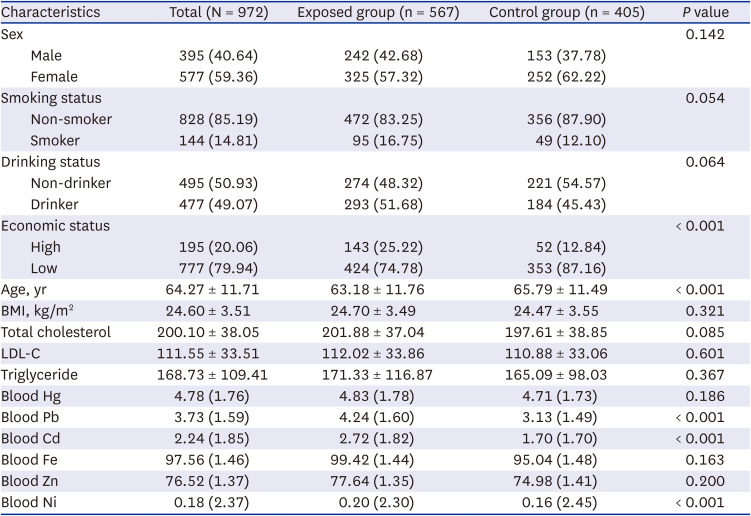
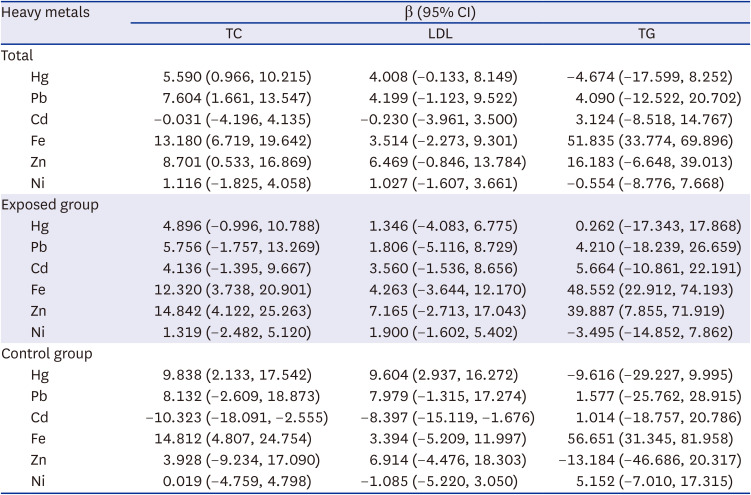
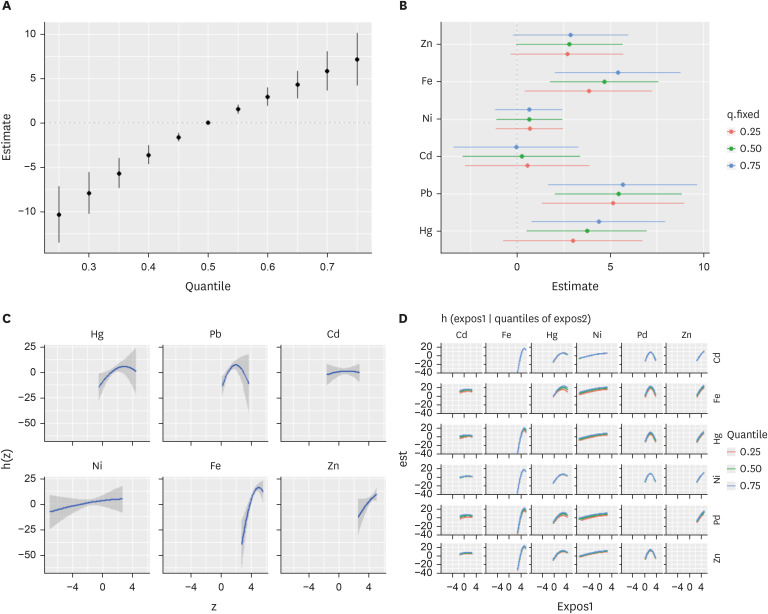
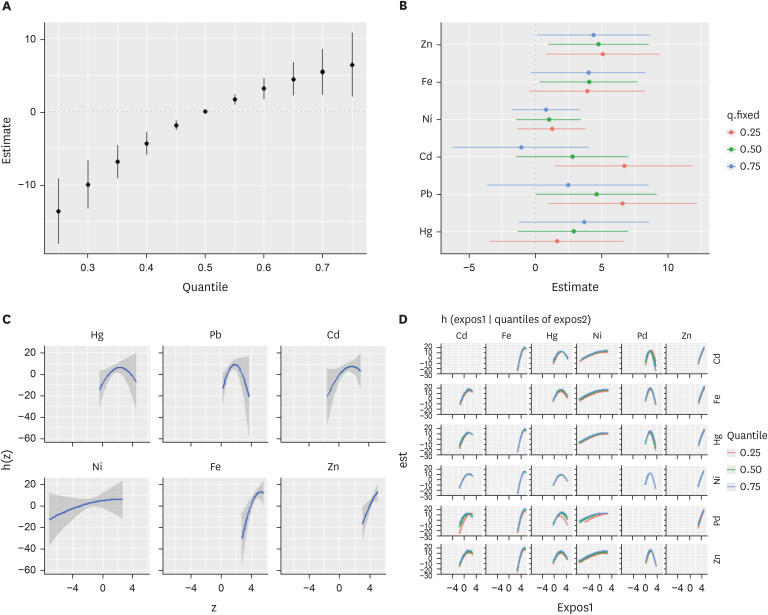
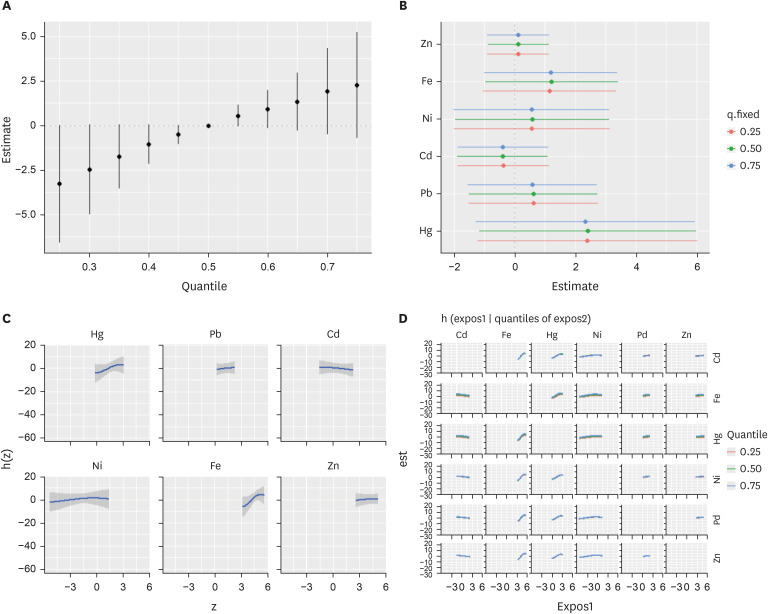




 PDF
PDF Citation
Citation Print
Print



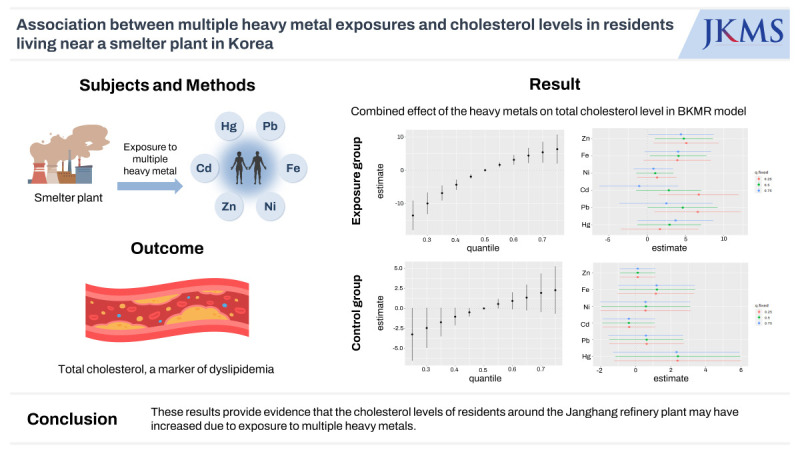

 XML Download
XML Download